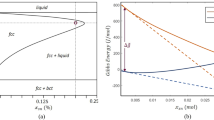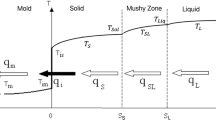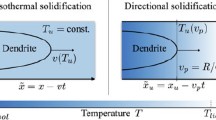Abstract
We present a numerical method for the simulation of binary alloys. We make use of the level-set method to capture the evolution of the solidification front and of an adaptive mesh refinement framework based on non-graded quadtree grids to efficiently capture the multiscale nature of the alloys’ concentration profile. In addition, our approach is based on a sharp treatment of the boundary conditions at the solidification front. We apply this algorithm to the solidification of an Ni–Cu alloy and report results that agree quantitatively with theoretical analyses. We also apply this algorithm to show that solidification mechanism maps predicting growth regimes as a function of tip velocities and thermal gradients can be accurately computed with this method; these include the important transitions from planar to cellular to dendritic regimes.
















Similar content being viewed by others
References
Rogich, D., Matos, G.: The global flows of metals and minerals. In: Technical Report 1355, USGS Open File Report, Reston, VA (2008)
Seth, B.B.: Superalloys: the utility gas turbine perspective. In: Pollock, T.M., Kissinger, R.D., Bowman, R.R., et al. (eds.) Superalloys 2000, pp. 3–16. The Minerals, Metals and Materials Society (TMS), Warrendale, PA (2000)
Schafrik, R., Sprague, R.: Gas turbine materials. Adv. Mater. Process. 5, 29–34 (2004)
Pollock, T., Tin, S.: Nickel-based superalloys for advanced turbine engines: chemistry, microstructure and properties. AIAA J. Propuls. Power 22, 361–374 (2006)
Reed, R.C.: The Superalloys: Fundamentals and Applications. Cambridge University Press, Cambridge (2006)
Elliott, A., Pollock, T., Tin, S., King, W., Huang, S.-C., Gigliotti, M.: Directional solidification of large superalloy castings with radiation and liquid-metal cooling: a comparative assessment. Metall. Mater. Trans. A 35, 3221–3231 (2004)
Brundidge, C., Miller, J., Pollock, T.: Development of dendritic structure in the liquid-metal cooled directional solidification process. Metall. Mater. Trans. 42A, 2723–2732 (2011)
Brundidge, C., Pollock, T.: Processing to fatigue properties: benefits of high gradient casting for single crystal airfoils. In: Superalloys 2012, Proceedings 12th International Conference on Superalloys, TMS (2012)
Madison, J., Spowart, J., Rowenhorst, D., Aagesen, L., Thornton, K., Pollock, T.: Modeling fluid flow in three-dimensional single crystal dendritic structures. Acta Mater. 58, 2864–2875 (2010)
Madison, J., Spowart, J., Rowenhorst, D., Aagesen, L., Thornton, K., Pollock, T.: Fluid flow and defect formation in the 3-dimensional dendritic structure of nickel-base single crystals. Metall. Mater. Trans. 43A, 369 (2012)
Davis, S.: Theory of Solidification. Cambridge University Press, Cambridge (2001)
Zhu, M., Stefanescu, D.: Virtual front tracking model for the quantitative modeling of dendritic growth in solidification of alloys. Acta Mater. 55(5), 1741–1755 (2007)
McFadden, G.B., Coriell, S.R., Sekerka, R.F.: Effect of surface free energy anisotropy on dendrite tip shape. Acta Mater. 48(12), 3177–3181 (2000)
Kurz, W.: Dendritic growth. Int. Mater. Rev. 39(26), 49–74 (1994)
Meiron, D.: Selection of steady-states in the two-dimensional symmetric model of dendritic growth. Phys. Rev. A. 33, 2704 (1986)
Ben Amar, M., Pelcé, P.: Impurity effect on dendritic growth. Phys. Rev. A 39(8), 4263–4269 (1989)
Langer, J.S.: Models of pattern formation in first-order phase transitions. In: Grinstein, G., Mazenko, G. (eds.) Directions in Condensed Matter Physics, p. 165. World Scientific, Singapore (1986)
Karma, A., Rappel, W.-J.: Quantitative phase-field modeling of dendritic growth in two and three dimensions. Phys. Rev. E 57, 4323–4349 (1997)
Karma, A.: Phase-field formulation for quantitative modeling of alloy solidification. Phys. Rev. Lett. 87, 115701 (2001)
Nestler, B., Danilov, D., Galenko, P.: Crystal growth of pure substances: phase-field simulations in comparison with analytical and experimental results. J. Comput. Phys. 207, 221–239 (2005)
Schmidt, A.: Computation of three dimensional dendrites with finite elements. J. Comput. Phys. 125, 293–312 (1996)
Karma, A., Rappel, W.J.: Phase-field modeling method for computationally efficient modeling of solidification with arbitrary interface kinetics. Phys. Rev. E 53, R3017–R3020 (1996)
Echebarria, B., Folch, R., Karma, A., Plapp, M.: Quantitative phase-field model of alloy solidification. Phys. Rev. E 70, 061604 (2004)
Pons, A.J., Karma, A., Akamatsu, S., Newey, M., Pomerance, A., Singer, H., Losert, W.: Feedback control of unstable cellular solidification fronts. Phys. Rev. E 75, 021602 (2007)
Asta, M., Beckermann, C., Karma, A., Kurz, W., Napolitano, R., Plapp, M., Purdy, G., Rappaz, M., Trivedi, R.: Solidification microstructures and solid-state parallels: recent developments, future directions. Acta Mater. 57, 941–971 (2009)
Gurevich, S., Karma, A., Plapp, M., Trivedi, R.: Phase-field study of three-dimensional steady-state growth shapes in directional solidification. Phys. Rev. E 81, 011603 (2010)
Kopczynski, P., Rappel, W.-J., Karma, A.: Critical role of crystalline anisotropy in the stability of cellular array structures in directional solidification. Phys. Rev. Lett. 77, 3387–3390 (1996)
Hurle, D.T.: Handbook of Crystal Growth. North Holland (1993)
Elder, K., Grant, M., Provatas, N., Kosterlitz, J.: Sharp interface limits of phase-field models. SIAM J. Appl. Math. 64, 21604 (2001)
Boettinger, W.J., Warren, J.A., Beckermann, C., Karma, A.: Phase-field simulations of solidification. Ann. Rev. Mater. Res. 32, 163–194 (2002)
Chen, L.-Q.: Phase-field models for microstructure evolution. Ann. Rev. Mater. Res. 32, 113–40 (2002)
George, W.L., Warren, J.A.: A parallel 3d dendritic growth simulator using the phase-field method. J. Comput. Phys. 177(2), 264–283 (2002)
Stinner, B., Nestler, B., Garcke, H.: A diffuse interface model for alloys with multiple components and phases. SIAM J. Appl. Math. 64, 775–799 (2004)
Dorr, M., Fattebert, J.-L., Wickett, M., Belak, J., Turchi, P.: A numerical algorithm for the solution of a phase-field model of polycrystalline materials. J. Comput. Phys. 229(3), 626–641 (2010)
Karagadde, S., Bhattacharya, A., Tomar, G., Dutta, P.: A coupled VOF-IBM-enthalpy approach for modeling motion and growth of equiaxed dendrites in a solidifying melt. J. Comput. Phys. 231(10), 3987–4000 (2012)
Jeong, J.-H., Goldenfeld, N., Dantzig, J.: Phase field model for three-dimensional dendritic growth with fluid flow. Phys. Rev. E 64, 41602 (2001)
Tryggvason, G., Bunner, B., Esmaeeli, A., Juric, D., Al-Rawahi, N., Tauber, W., Han, J., Nas, S., Jan, Y.-J.: A front-tracking method for the computations of multiphase flow. J. Comput. Phys. 169, 708–759 (2001)
Heinrich, J., Zhao, P.: Front tracking finite element method for dendritic solidification. J. Comput. Phys. 173, 765–796 (2001)
Zhao, P., Vénere, M., Heinrich, J., Poirier, D.: Modeling dendritic growth of a binary alloy. J. Comput. Phys. 188(2), 434–461 (2003)
Singh, R., Shyy, W.: Three-dimensional adaptive cartesian grid method with conservative interface restructuring and reconstruction. J. Comput. Phys. 224(1), 150–167 (2007)
Al-Rawahi, N.: Numerical simulation of dendritic solidification with convection: two-dimensional geometry. J. Comput. Phys. 180(2), 471–496 (2002)
Eck, C., Knabner, P., Korotov, S.: A two-scale method for the computation of solid–liquid phase transitions with dendritic microstructure. J. Comput. Phys. 178(1), 58–80 (2002)
Möller, P., Hansbo, P.: On advancing front mesh generation in three dimensions. Int. J. Num. Methods Eng. 38, 3551–3569 (1995)
Fedoseyev, A.I., Alexander, J.D.: An inverse finite element method for pure and binary solidification problems. J. Comput. Phys. 130(2), 243–255 (1997)
Skeldon, A., Cliffe, K., Riley, D.: Grid design for the computation of a hexagon-roll interaction using a finite element method. J. Comput. Phys. 133(1), 18–26 (1997)
Bars, M.L., Worster, M.G.: Solidification of a binary alloy: Finite-element, single-domain simulation and new benchmark solutions. J. Comput. Phys. 216(1), 247–263 (2006)
Zabaras, N., Ganapathysubramanian, B., Tan, L.: Modelling dendritic solidification with melt convection using the extended finite element method. J. Comput. Phys. 218(1), 200–227 (2006)
Tan, L., Zabaras, N.: A level set simulation of dendritic solidification of multi-component alloys. J. Comput. Phys. 221(1), 9–40 (2007)
Tan, L., Zabaras, N.: Modeling the growth and interaction of multiple dendrites in solidification using a level set method. J. Comput. Phys. 226(1), 131–155 (2007)
Tan, L., Zabaras, N.: Multiscale modeling of alloy solidification using a database approach. J. Comput. Phys. 227(1), 728–754 (2007)
Min, C., Gibou, F.: A second order accurate level set method on non-graded adaptive Cartesian grids. J. Comput. Phys. 225(1), 300–321 (2007)
Chen, H., Min, C., Gibou, F.: A numerical scheme for the Stefan problem on adaptive Cartesian grids with supralinear convergence rate. J. Comput. Phys. 228(16), 5803–5818 (2009)
Chen, H., Min, C., Gibou, F.: A second-order accurate FDM for the heat equation on irregular domains and adaptive grids. In: Proceedings of the Materials Research Society Symposium, San Francisco, CA, USA, vol. 910, pp. 907–910 (2006)
Benson, D.: Computational methods in Lagrangian and Eulerian hydrocodes. Comput. Methods Appl. Mech. Eng. 99, 235–394 (1992)
Benson, D.: Volume of fluid interface reconstruction methods for multimaterial problems. Appl. Mech. Rev. 52, 151–165 (2002)
DeBar, R.: Fundamentals of the KRAKEN code. Technical Report, Lawrence Livermore National Laboratory (UCID-17366) (1974)
Noh, W., Woodward, P.: SLIC (simple line interface calculation). In: 5th International Conference on Numerical Methods in Fluid Dynamics, 1976, pp. 330–340 (1976)
Youngs, D.: An interface tracking method for a 3D Eulerian hydrodynamics code. Technical Report, AWRE (44/92/35) (1984)
Dyadechko, V., Shashkov, M.: Moment-of-fluid interface reconstruction. Technical Report, Los Alamos National Laboratory (LA-UR-05-7571) (2006)
Popinet, S.: An accurate adaptive solver for surface-tension-driven interfacial flows. J. Comput. Phys. 228(16), 5838–5866 (2009)
Glimm, J., Grove, J.W., Li, X.L., Zhao, N.: Simple front tracking. Contemp. Math. 238, 133–149 (1999)
Juric, D.: A front-tracking method for dendritic solidification. J. Comput. Phys. 123(1), 127–148 (1996)
Juric, D., Tryggvason, G.: Computations of boiling flows. Int. J. Multiph. Flow 24, 387–410 (1998)
Osher, S., Sethian, J.A.: Fronts propagating with curvature dependent speed: algorithms based on hamilton-jacobi formulations. J. Comput. Phys. 79(1), 12–49 (1988)
Osher, S., Fedkiw, R.P.: Level set methods: an overview and some recent results. J. Comput. Phys. 169, 463–502 (2001)
Sethian, J.A.: Level Set Methods and Fast Marching Methods. Cambridge University Press, Cambridge (1999)
Olsson, E., Kreiss, G.: A conservative level set method for two phase flow. J. Comput. Phys. 210, 225–246 (2005)
Enright, D., Fedkiw, R., Ferziger, J., Mitchell, I.: A hybrid particle level set method for improved interface capturing. J. Comput. Phys. 183, 83–116 (2002)
Sussman, M., Puckett, E.G.: A coupled level set and volume-of-fluid method for computing 3d and axisymmetric incompressible two-phase flows. J. Comput. Phys. 162(2), 301–337 (2000)
Chen, S., Merriman, B., Osher, S., Smereka, P.: A simple level set method for solving Stefan problems. J. Comput. Phys. 135, 8–29 (1997)
Kim, Y.-T., Goldenfeld, N., Dantzig, J.: Computation of dendritic microstructures using a level set method. Phys. Rev. E 62, 2471–2474 (2000)
Gibou, F., Fedkiw, R., Caflisch, R., Osher, S.: A level set approach for the numerical simulation of dendritic growth. J. Sci. Comput. 19, 183–199 (2003)
Yang, Y., Udaykumar, H.: Sharp interface cartesian grid method iii: Solidification of pure materials and binary solutions. J. Comput. Phys. 210(1), 55–74 (2005)
Gibou, F., Fedkiw, R., Cheng, L.-T., Kang, M.: A second-order-accurate symmetric discretization of the Poisson equation on irregular domains. J. Comput. Phys. 176, 205–227 (2002)
Gibou, F., Fedkiw, R.: A fourth order accurate discretization for the Laplace and heat equations on arbitrary domains, with applications to the Stefan problem. J. Comput. Phys. 202, 577–601 (2005)
Chen, H., Min, C., Gibou, F.: A supra-convergent finite difference scheme for the Poisson and heat equations on irregular domains and non-graded adaptive Cartesian grids. J. Sci. Comput. 31(1–2), 19–60 (2007)
Chang, A., Dantzig, J.A., Darr, B.T., Hubel, A.: Modeling the interaction of biological cells with a solidifying interface. J. Comput. Phys. 226(2), 1808–1829 (2007). doi:10.1016/j.jcp.2007.05.039
Aftosmis, M.J., Berger, M.J., Melton, J.E.: Adaptive Cartesian mesh generation. In: CRC Handbook of Mesh Generation (Contributed Chapter) (1998)
Brun, E., Guittet, A., Gibou, F.: A local level-set method using a hash table data structure. J. Comput. Phys. 231, 2528–2536 (2012)
Gibou, F., Min, C.: On the performance of a simple parallel implementation of the ILU-PCG for the poisson equation on irregular domains. J. Comput. Phys. 231(14), 4531–4536 (2012)
Losasso, F., Gibou, F., Fedkiw, R.: Simulating water and smoke with an octree data structure. In: ACM Transactions Graph (SIGGRAPH Proceedings) pp. 457–462 (2004)
Min, C., Gibou, F., Ceniceros, H.: A supra-convergent finite difference scheme for the variable coefficient Poisson equation on non-graded grids. J. Comput. Phys. 218(1), 123–140 (2006)
Min, C., Gibou, F.: A second order accurate projection method for the incompressible navier-stokes equations on non-graded adaptive grids. J. Comput. Phys. 219(2), 912–929 (2006)
Min, C., Gibou, F.: Geometric integration over irregular domains with application to level-set methods. J. Comput. Phys. 226(2), 1432–1443 (2007)
Min, C., Gibou, F.: Robust second-order accurate discretizations of the multi-dimensional Heaviside and Dirac delta functions. J. Comput. Phys. 227(22), 9686–9695 (2008)
Mirzadeh, M., Theillard, M., Gibou, F.: A second-order discretization of the Nonlinear Poisson–Boltzmann equation over irregular geometries using non-graded adaptive Cartesian grids. J. Comput. Phys. 230(5), 2125–2140 (2010)
Papac, J., Gibou, F., Ratsch, C.: Efficient symmetric discretization for the Poisson, heat and Stefan-type problems with Robin boundary conditions. J. Comput. Phys. 229(3), 875–889 (2010)
Helgadóttir, A., Gibou, F.: A Poisson–Boltzmann solver on irregular domains with Neumann or Robin boundary conditions on non-graded adaptive grid. J. Comput. Phys. 230(10), 3830–3848 (2011)
Miniati, F., Colella, P.: Block structured adaptive mesh and time refinement for hybrid, hyperbolic, n-body systems. J. Comput. Phys. 227(1), 400–430 (2007)
Estep, D., Tavener, S., Wildey, T.: A posteriori error estimation and adaptive mesh refinement for a multiscale operator decomposition approach to fluid-solid heat transfer. J. Comput. Phys. 229(11), 4143–4158 (2010)
Ceniceros, H.D., Nós, R.L., Roma, A.M.: Three-dimensional, fully adaptive simulations of phase-field fluid models. J. Comput. Phys. 229(17), 6135–6155 (2010)
Provatas, N., Goldenfeld, N., Dantzig, J.: Efficient computation of dendritic microstructures using adaptive mesh refinement. Phys. Rev. Lett. 80, 3308 (1998)
Provatas, N., Goldenfeld, N., Dantzig, J.: Adaptive mesh refinement computation of solidification microstructure using dynamic data structures. J. Comput. Phys 148, 265 (1999)
Shu, C.-W., Osher, S.: Efficient implementation of essentially non-oscillatory shock capturing schemes II. J. Comput. Phys. 83, 32–78 (1989)
Liu, X.-D., Osher, S., Chan, T.: Weighted essentially non-oscillatory schemes. J. Comput. Phys. 126, 202–212 (1996)
Strain, J.: Tree methods for moving interfaces. J. Comput. Phys. 151, 616–648 (1999)
Min, C.: Local level set method in high dimension and codimension. J. Comput. Phys. 200, 368–382 (2004)
Fedkiw, R., Aslam, T., Merriman, B., Osher, S.: A non-oscillatory Eulerian approach to interfaces in multimaterial flows (the ghost fluid method). J. Comput. Phys. 152, 457–492 (1999)
Liu, X.D., Fedkiw, R., Kang, M.: A boundary condition capturing method for Poisson’s equation on irregular domains. J. Comput. Phys. 154, 151 (2000)
Mirzadeh, M., Theillard, M., Helgadottir, A., Boy, D., Gibou, F.: An adaptive, finite difference solver for the nonlinear poisson-boltzmann equation with applications to biomolecular computations. Commun. Comput. Phys. 13, 150–173 (2013)
Aslam, T.: A partial differential equation approach to multidimensional extrapolation. J. Comput. Phys. 193, 349–355 (2004)
Adalsteinsson, D., Sethian, J.: A fast level set method for propagating interfaces. J. Comput. Phys. 118, 269–277 (1995)
Theillard, M., Rycroft, C.H., Gibou, F.: A multigrid method on non-graded adaptive octree and quadtree Cartesian grids. J. Sci. Comput. 55, 1–15 (2013)
Brandt, A.: Multi-level adaptive solutions to boundary-value problems. Math. Comput. 31, 333–390 (1977)
Mullins, W.W., Sekerka, R.F.: Stability of a planar interface during solidification of a dilute binary alloy. J. Appl. Phys. 5, 323–329 (1964)
Kurz, W., Fisher, D.J.: Fundamentals of Solidification. Trans Tech Publication, Aedermannsdorf, Switzerland (1998)
Acknowledgments
We would like to thank Dr. Jonathan Miller for stimulating discussions at UCSB and AFRL about solidification of binary alloys. We also thank Christopher Harrel for running some simulations while interning in the Computational Applied Science Laboratory as part of the CNSI INSET program at UCSB. The research of M. Theillard and F. Gibou was supported in part by ONR N00014-11-1-0027, NSF CHE 1027817 and by the W.M. Keck Foundation. In addition M. Theillard acknowledges support from a Dean’s fellowship at UCSB. T. Pollock was supported in part by NSF DMREF Grant DMR 1233704.
Author information
Authors and Affiliations
Corresponding author
Rights and permissions
About this article
Cite this article
Theillard, M., Gibou, F. & Pollock, T. A Sharp Computational Method for the Simulation of the Solidification of Binary Alloys. J Sci Comput 63, 330–354 (2015). https://doi.org/10.1007/s10915-014-9895-0
Received:
Revised:
Accepted:
Published:
Issue Date:
DOI: https://doi.org/10.1007/s10915-014-9895-0




